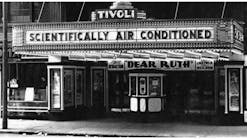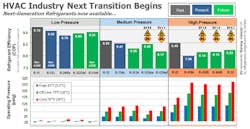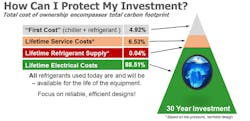With the world’s attention increasingly focused on climate change, organizations are more attuned to carbon-footprint implications during the building-design process and the impacts buildings have on the environment. HVAC-system efficiency plays a crucial role in a building’s environmental impact. While it is important to choose equipment that delivers high-efficiency performance, it is even more critical to consider a building’s entire HVAC system during design.
A system approach puts designers in a much better position to help building owners and managers achieve their goals, enabling them to maximize building performance while minimizing environmental impact.
HVAC-system efficiency is impacted by not only the type of equipment selected, but the choice of refrigerant. This is especially relevant now, as the HVAC industry begins another transition in refrigerants for chillers and, eventually, other equipment.
You should be aware of the changes—and available options—to ensure HVAC systems meet changing refrigerant standards, regulations, and legislation without compromising efficiency and safety.
The Transition Is Happening
When evaluating next-generation refrigerant alternatives, it is important to balance direct environmental concerns, such as ozone-depletion potential (ODP), global-warming potential (GWP), and leak rates, with indirect impacts. Indirect impacts refers to the energy used to power HVAC systems, which largely is generated by burning fossil fuels that emit greenhouse gases (GHGs). When both direct and indirect impacts are considered, high-performance, environmentally responsible systems can be designed.
Pressure to reduce the use of high-GWP refrigerants has been mounting for years. In response, the 197 signatories of the Montreal Protocol on Substances That Deplete the Ozone Layer, including the United States, Canada, and Mexico, agreed last year to amend the treaty as the vehicle of choice to phase down hydrofluorocarbons (HFCs) on a GWP-weighted basis. And on Oct. 16, 2016, the parties to the Montreal Protocol passed the Kigali Amendment, beginning the global phasedown of HFCs.
Further, on Sept. 26, 2016, the U.S. Environmental Protection Agency issued two rules. The first bans the use of HFCs R-134a, R-410A, and R-407C in new chillers (air-cooled, water-cooled, scroll, screw, centrifugal) beginning Jan. 1, 2024. The second tightens the refrigerant-management requirements of Section 608 of the Clean Air Act effective Jan. 1, 2019. The second rule also extends requirements for ozone-depleting substances to include all replacements, including HFCs and new hydrofluoroolefin (HFO) options. More-stringent leak-tightness requirements in this rule may push the industry to move to technologies that are more hermetic, with fewer joints and seals, for long-term refrigerant containment.
Options
With final phaseouts of hydrochlorofluorocarbons (HCFCs) approaching and the impending phasedown of HFCs, new low-GWP solutions are emerging. As in the past, the selection of refrigerants continues to be a balancing act between various factors, including safety (flammability and toxicity) and efficiency.
Looking back, the industry adopted chlorofluorocarbons (CFCs) because of their safety and efficiency relative to previous options. When it was determined they were contributing to the depletion of the ozone layer, CFCs quickly were phased out and replaced with HCFCs, such as R-22 and R-123, with much lower ODP and HFCs, such as R-134a, R-407C, and R-410A, with zero ODP. Scientists later determined many HFCs are strong GHGs, meaning they trap heat in the atmosphere, which brought HFCs under scrutiny.
Phaseout dates for HCFCs have been established. For example, R-22 production is being reduced rapidly; by 2019, it will have reached the “service tail” portion of its phaseout, meaning consumers still will be able to purchase it (though supplies will be limited), but complete packaged systems effectively no longer will be available.
Based on a carbon-dioxide baseline value of 1.0, R-123 has a GWP of 79, while HFCs such as R-134a and R-410A—sometimes referred to as “potent GHGs”—have GWPs of 1,300 and 1,924, respectively. With increased GHG emissions resulting from the growing use of HFCs, there are heightened legislative and regulatory pressures on HFC use around the world.
What’s Next
The next class of refrigerants is characterized by very short atmospheric lives (measured in months or even days, as opposed to years), which results in “effectively zero” ODP and very low GWP. In general, the shorter the atmospheric life, the lower the environmental impact because the chemical does not survive long enough to reach the stratosphere. One of the reasons HFCs are under pressure is because they have relatively long atmospheric lives. For example, R-134a survives 14 years, while hydrochlorofluoroolefin (HCFO) R-1233zd(E) survives only 29 days.
The next class of refrigerants consists of HCFOs, HFOs, and HFO blends and includes new options such as R-1233zd(E); HFOs R-1234yf, R-1234ze(E), and R-1336mzz(Z); and HFO blends R-513A, R-514A, and R-452B.
Impacts on Efficiency
Even with the ongoing changes, it is possible to design efficient systems and buildings using these next-generation options; it just takes new thinking.
The rule of thumb is that the lower the pressure, the more efficient the refrigerant. A possible downside of lower pressure is the larger physical size of equipment. Specifically, the choice between low-, medium-, and high-pressure options often depends on the size of the project and the needs of the application. The smaller the application, the more cost-effective it becomes to use higher-pressure refrigerants, as it enables smaller packaging of equipment.
Safety Considerations
The Air-Conditioning, Heating, and Refrigeration Institute (AHRI) has brought together the HVAC community through the Alternative Refrigerants Evaluation Program (AREP) to investigate next-generation refrigerants and their suitability for HVAC applications.
Many of the new low-GWP refrigerants are flammable. To deal with them, a new flammability subclass was created. ANSI/ASHRAE Standard 34, Designation and Safety Classification of Refrigerants, once had three flammability classes: Class 1 (nonflammable), Class 2 (low flammability), and Class 3 (highly flammable). To those, subclassification 2L—defined as “difficult to ignite and sustain a flame,” or, essentially, slightly flammable—was added.
The developing reality that we likely will need to leverage 2L fluids has driven experimentation, resulting in a greater understanding that not all 2L fluids are created equal. For example, R-452B, R-1234yf, and R-1234ze(E) are on the lower-flammability side of the 2L spectrum, while R-32 and ammonia are on the higher-flammability side. Ultimately, the aim, of course, is to use the least-flammable fluids possible.
The next step for industry leaders is to develop standards enabling adoption of these new flammable refrigerants. Specifically, ANSI/ASHRAE Standard 15, Safety Standard for Refrigeration Systems, and UL 60335-2-40, Safety of Household and Similar Electrical Appliances, Part 2-40: Particular Requirements for Electrical Heat Pumps, Air-Conditioners and Dehumidifiers, will need to be updated to include more reasonable requirements for the less-flammable 2L refrigerants. Today, leveraging equipment using a 2L refrigerant is difficult because of the lack of documented methods for indoor installation. While 2L refrigerants easily can be installed outdoors, more stringent standards requirements (e.g., high ventilation, explosionproof motors, etc.) are required for 2L refrigerants to be applied indoors.
Designing building systems with this new class of refrigerants is a matter of trade-offs in finding options that are environmentally responsible, can be used safely, and deliver the performance and efficiency building owners and managers require.
Plan for Tomorrow
Understanding the shifting refrigerant landscape today can help you design building systems that meet changing standards tomorrow. Focus first on whole-system efficiency and choosing HVAC equipment you can count on to deliver the performance your building requires.
The reality is there is no perfect refrigerant. Refrigerant selection is a matter of taking a balanced approach, considering environmental impacts, safety, and efficiency.
Next-generation refrigerants that have low GWP, are nonflammable, and are efficient are available today. It is important to evaluate your options to be prepared for the future.
Ryan Geister is systems leader for Trane, a brand of Ingersoll-Rand. During his 20 years with the company, he has held various roles supporting many areas of the business, most recently chillers. He is the chairman of the Air-Conditioning, Heating, and Refrigeration Institute (AHRI) Chiller Section Committee and a member of the AHRI Board of Directors and ASHRAE.
Did you find this article useful? Send comments and suggestions to Executive Editor Scott Arnold at [email protected].











